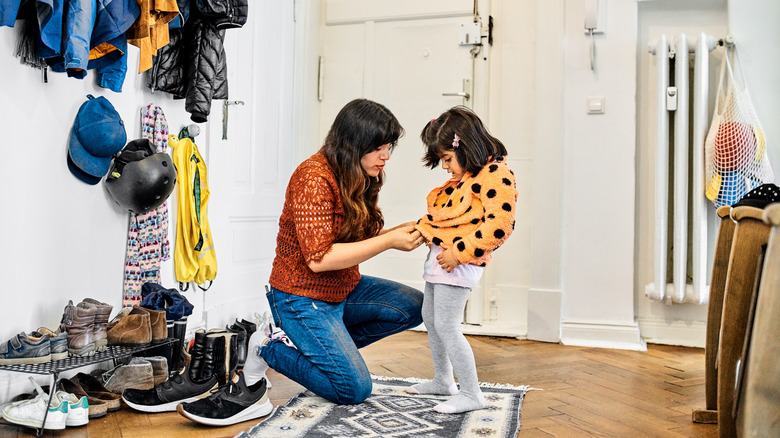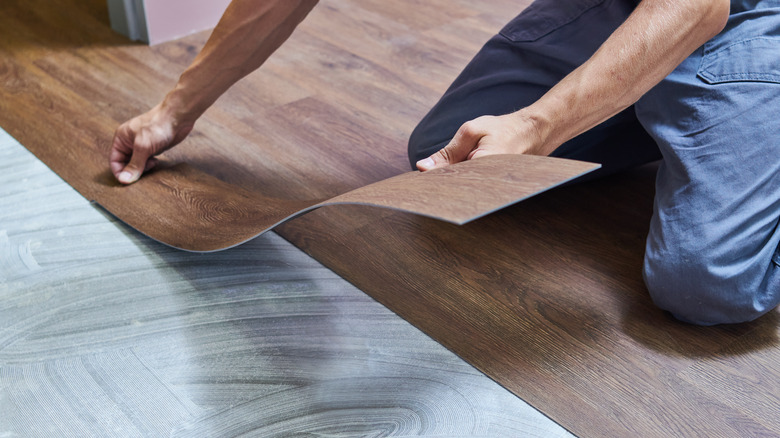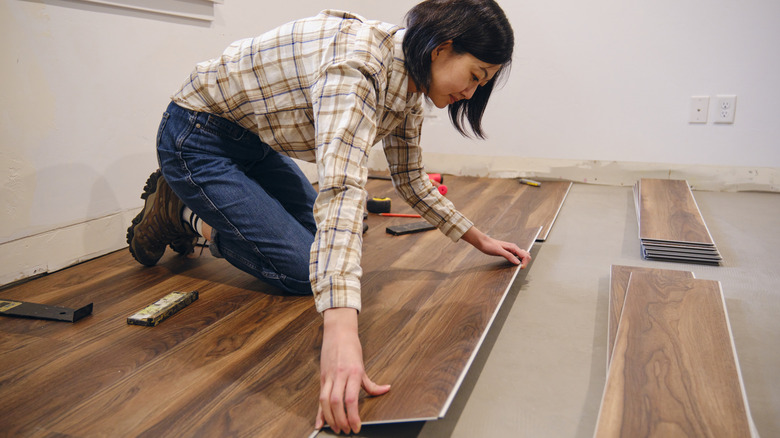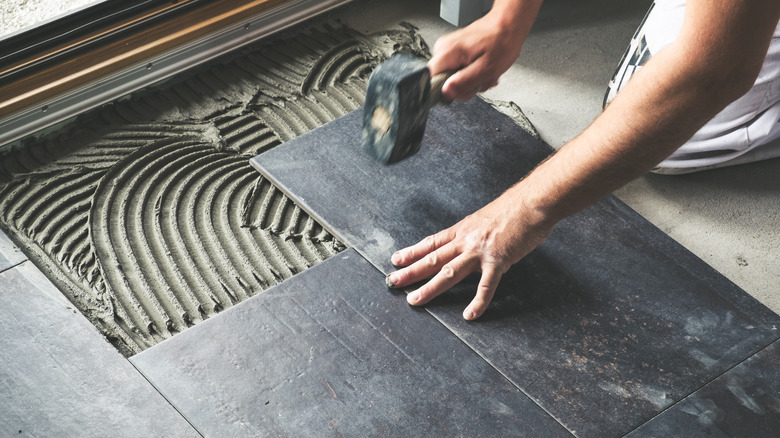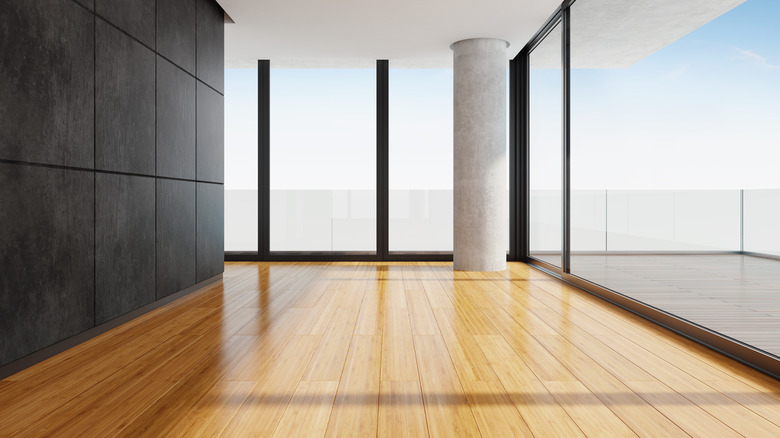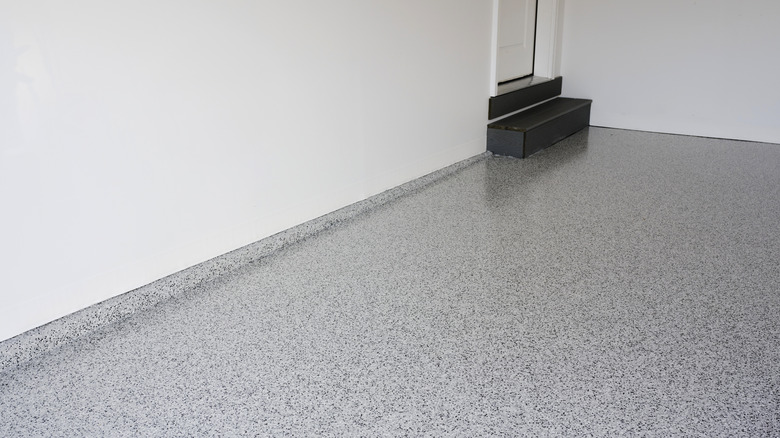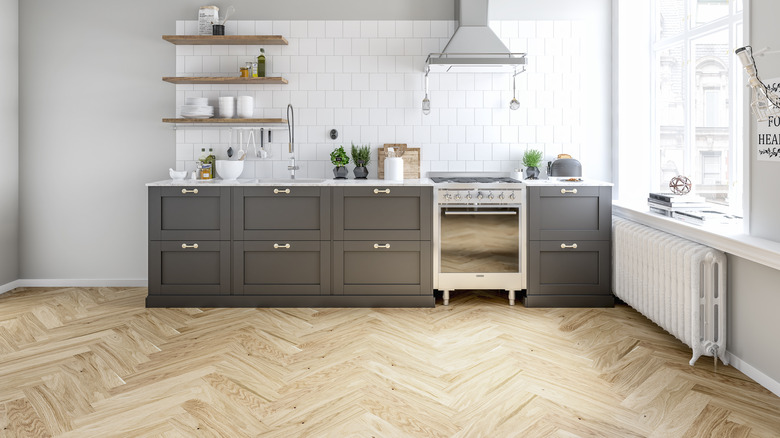The 6 Best Flooring Options For Your Mudroom
For many homeowners — especially those who live with dogs or children — a mudroom is more than just a bonus; it's a necessity that warrants paying more for a house. When you or your beloved family member enters your home wearing shoes or clothes covered in dirt or mud, your mudroom acts as a barrier between the incoming mess and the precious rest of your house. While this can be a blessing for your main living area, the room's purpose can also pose a unique challenge when it comes to choosing a suitable type of flooring.
In order to keep up with the high-traffic, high-maintenance nature of a room that is designed for walking through and catching messes, a durable, easy-to-clean flooring choice is required. While an aesthetically pleasing option like traditional hardwood or natural stone tile may look stylish, a more damage-resistant choice like vinyl or ceramic tile is more likely to stand up to the demands of a busy, frequently-cleaned area. Consider this your guide to selecting flooring, whether you're building a mudroom from scratch or just updating your home.
Vinyl
When it comes to flooring that is easy to clean and can stand up to both frequent cleaning and high traffic, vinyl is incredibly difficult to beat. Available in sheets, tiles, or planks in nearly every imaginable color and pattern, vinyl flooring is created by layering synthetic components including PVC, plastic, and fiberglass. Since the visible layer is a printed image beneath a protective coating, vinyl can mimic higher-quality types of flooring such as wood or porcelain.
Vinyl is easy to clean, and waterproof varieties can withstand damp or wet mopping on a frequent basis. This is a flooring option that is durable, scuff and stain resistant, and can decently stand the test of time with very little maintenance. It is also one of the lowest-priced options you'll come across that is suitable for a mudroom setting. This does mean that adding vinyl flooring to your home won't necessarily increase its value. You also won't have the option of refinishing your vinyl floor; once it has been damaged, it will need to be replaced — especially if it is sheet vinyl.
Laminate
If you dream of the appearance of hardwood in your mudroom but don't want to commit to the level of maintenance it requires in such a high-traffic area, laminate may be the best choice for your home. Laminate flooring is made out of layers of synthetic materials including a fiberboard core, a high-resolution realistic image layer, and a protective plastic top layer. High-quality modern varieties of laminate can quite realistically mimic the appearance of hardwood (or stone tile).
While a laminate floor cannot be refinished the way a hardwood floor can, it offers a higher level of resistance to scratches, scuffs, and stains. Many varieties are marketed as waterproof as well, but laminate flooring is not truly impervious to damage from moisture. A laminate floor is easy to clean, but it should never be saturated with water or solvent. Instead, it can be cleaned with a damp mop. In comparison to hardwood, laminate flooring is a significantly more affordable choice, but the cheaper options may wear more easily over time.
Ceramic tile
Looking for classic, clean, sophisticated look for your mudroom? Ceramic tile offers a sleek, simple, high-quality look without a particularly high price or a lot of maintenance. Though it can look similar to natural stone tile, ceramic tile is created by baking natural clay in a kiln and then coating it with a glassy protective glaze. Glazed ceramic tiles are available in a vast array of colors and patterns. High-resolution imaging can even be incorporated to create tiles that mimic more expensive materials, like marble.
Since ceramic tile flooring is sealed with grout between each tile, it is considered quite resistant to water and humidity, making it ideal for a mudroom that houses tracked-in snow and/or requires frequent mopping. However, grout can be challenging to clean and does sometimes need to be replaced, if cracking or molding occurs. Thanks to the high-heat baking process and glazing that ceramic tiles undergo during the manufacturing process, they are especially strong, durable, and damage-resistant — making them ideal for a high-traffic area such as a mudroom. You do have to also consider that ceramic tiles can get cold. If you have sensitive feet, watch out for those cold tiles in the winter.
Bamboo
For those who are looking to take off their muddy boots in style, bamboo can serve as a suitable flooring option for a mudroom. Eco-friendly, trendy, durable, and even pest-resistant, bamboo flooring checks quite a few boxes for homeowners looking for a mudroom floor that won't detract from the desired aesthetic of their home. During the manufacturing process, bamboo stalks are sliced, sanded, and formed into planks that resemble hardwood. Bamboo flooring shares several other similarities to hardwood, including the tendency to scratch and stain, despite its overall ability to stand up to high traffic.
Luckily, (non-engineered) a bamboo floor can be refinished and sealed several times within its long lifespan. Bamboo flooring is easy to clean and more water-resistant than hardwood, but it is still sensitive to moisture. As Derek Brooks — former senior vice president of Torlys sales and business development — told Floor Covering News in 2021, "Bamboo flooring, being a grass, will resist moisture better than other hardwoods like oak and maple, making it a great choice for many areas of the home, except highly wet areas." This means dry sweeping and damp mopping are the ideal means of cleaning these floors. Since exposure to water can result in staining and warping, they are not ideal for homes in areas that receive heavy snowfall or mudrooms adjacent to a swimming pool or hot tub. When it comes to pricing, bamboo falls on the higher end of the scale.
Terrazzo
If you're in the market for mudroom flooring that can offer some modern artful pizazz, consider terrazzo. Terrazzo flooring is created by mixing chips of various decorative aggregates — like glass, stone, shell, and mineral compounds — into a concrete or epoxy base, resulting a mosaic-like appearance. The mixture can then be poured and set into pre-made tiles or poured directly over a concrete subfloor inside your home. In addition to the endless variations of aggregates, the base of a terrazzo floor can also be tinted to any color of your choosing.
Since terrazzo floors are sealed, they are resistant to moisture and can easily withstand frequent cleaning including wet mopping. This flooring option is so extremely durable that it is often used in commercial buildings due to its ability to withstand sustained heavy foot traffic. It's also highly customizable and tile variations are quite affordable. A poured terrazzo floor, on the other hand, will set you back a considerable amount of money.
Engineered hardwood
No matter how unideal hardwood floors are in some spaces, their undeniable charm sometimes just cannot be resisted. If you really want the look of actual hardwood flooring in your mudroom despite the risks involved in installing it in such a high-traffic, moisture-prone area, opt for engineered hardwood. Engineered hardwood is created similarly to laminate, but utilizes higher quality materials; a high-quality plywood core is topped with a thin slice of authentic hardwood and a protective sealant.
While engineered hardwood flooring is more resistant to water and moisture than traditional hardwood, it can still stain or warp when exposed to liquids. An engineered hardwood floor can stand up to heavy traffic and frequent cleaning, but care needs to be taken to remove drips or puddles immediately and mopping should be damp and not wet. Engineered hardwood is significantly more affordable than solid hardwood. However, it can only be refinished a few times, depending on its thickness, whereas traditional hardwood can generally withstand refinishing up to 10 times before needing to be replaced.
